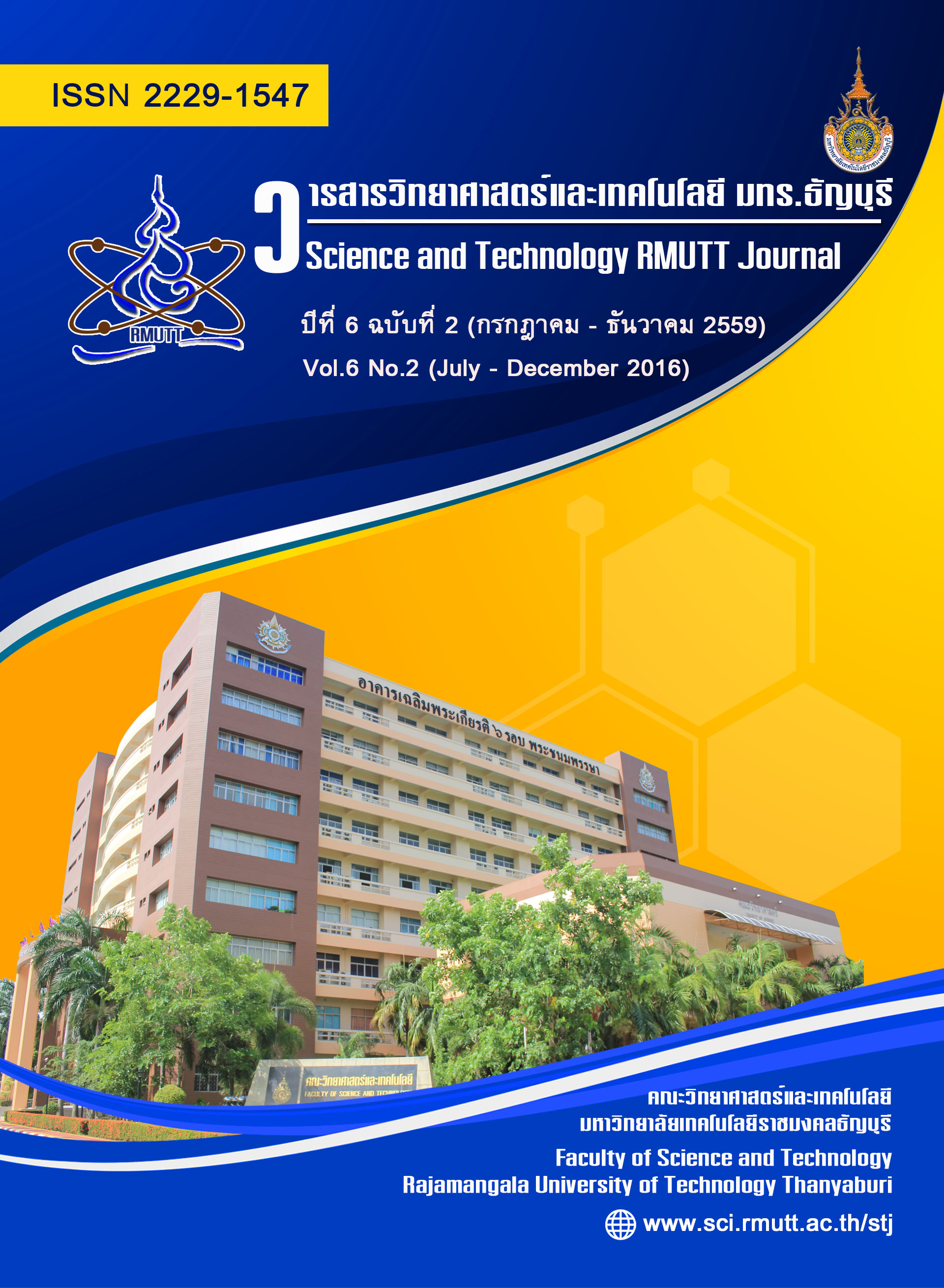Kombucha Production by Combinations of Black Tea and Apple Juice
Main Article Content
Abstract
This work aims to study the use of apple juice combined with black tea to produce Kombucha beverage, a tea-fermented beverage (AT-Kombucha) and to access its chemical and microbiological quality for food safety. After fermentation, AT-Kombucha was pasteurized and then filter sterilized. Predominant chemical compounds and microbial detection in AT Kombucha were analyzed. The results demonstrated that using apple juice as the culture substrate together with black tea to ferment AT Kombucha improved total phenols content. For the food safety view point, there was no foodborne pathogens detected followed the Notification of Thai Ministry of Public Health No. 356 (2013) for beverages in sealed container. Thus, the methods of fermentation and sterilization used in this study were proved to safe from biological hazard. In addition, there is a potential for commercial production of AT-Kombucha using the method and equipments in this study. In Thailand beverage market, there is no Kombucha product which fermented using fruit juice combined with black tea for increasing flavor and health-promoting.
Article Details
References
R. jayablan, R V. Malbasa, E. S. Loncar, J. S. Vitas, M. Sathishkuma. A Review on Kumbucha Tea-Microbillogy Composition Fermentation, Beneficial, Effects, Toxicity, and Tea Fungus. Compr Rev Food Sci. 13(2014): 538-550.
C. Deferens, E. Famworth. Tea, kombucha, and health: a review. Food Res Int. 33(2000): 409-21.
D. G. Stong., H. Mukhtar. Polyphenols as cancer chemopreventive agents. J. Cell. Biochem. 22(1995): 169-180.
R. H. Anken, T. Happei. Histochemical and anatomical observations upon the tea fungus. Eur Arch Biol. 103(1992): 219-22.
Batikh H. Rakhrouf A, Ammarb E. Antimicrobial effect of kombucha analogues. Food Sci Technol. 47(2012): 47:71-7.
J. Abshenas, A. Derakhshanfar, M. H. Ferdosi, S. Hasanzadeh. Protective effect of kombucha tea against acetaminophen-induced hepatotoxicity in mice: biochemical and histopathological study. Comp Clin Pathol 21(2012):1243-8.
สุนิษฐา เศรษฐีธร.ตลาดชาในประเทศไทย.ศูนย์อัจฉริยะเพื่ออุตสาหกรรมอาหารสถาบันอาหาร.2557: 3-9.
C. Dufresne E. Farnworth. Tea, Kumbucha, and Health: a review. Food Res Int.. 33(2000): 409-421.
C. Chen, B.Y. Liu. Changes in major components of tea fungus metabolites during prolonged fermentation. J. Appl. Microbiol. 89(2000): 834-839.
G. Johnsy, K. V. Ramana, S. N. Sabapathy, A. S. Bawa. Physico-mechanical propreties of chemically treated bacterial (Acetocacter xylinum) cellulose membrane. World J Microbiol Biotechnol 21(2005):1323-1327.
L. Kallel, V. Desseaux, M. Hamdi, P. Stocker, E. H. Ajandouz. Insighets into the fermentation biochemistry of kombucha teas and potential impacts of kombucha drinking on starch digestion. Food Res Int. 49(2012): 226-232.
S. Chunchom, S. Deeseenthum, C. Talubmook. Sub-acute toxicity of brown rice kefir powder. Sci Tech RMUTT J. 6(2016): 14-24.
C. H. Liu, W. H. Hsu, F. L. Lee, C. C. Liao. The isolation and identification of microbes from a fermented tea beverage. Haipao. Fermentation. Food Microbiol 13(1996): 407-15.
P. J. Blanc. Characterization of the tea fungus metabolites.Biotecnol Lett. 18(1996):139-142.
G. Williamson, D. Barron, K. Shimoi, J. Terao. In vitro biological properties of flavonoid conjugates found in vivo. Free Radic Res. 35(2005):201-205.
C. Dufresne, E. Farnworth. Tea, kombucha, and health: a review. Food Res Int. 33(2000):409-421.
H. Batikh, A. Rakhrouf, E. Ammarb. Antimicrobial effect of kombucha analogues. Food Sci Technol 47(2012): 71-7.
A. Mohammadshirazi,E. B. Kalhor. Energy and Cost Aanalyses of Kombucha Beverage Production. Renew Sust Energ Rev. 55 (2016): 668-673.
T.-Y. Sun, J.-S. Li, C. Chen. Effects of Blending Wheatgrass Juice on Enhancing Phenolic Compounds and Antioxidant Activities of Traditional Kombucha Beverage. J Food Drug Anal. 23 (2015): 709-781.
A. Alverti, T. P. M. dos Santos ,A. A. F. Zielinski, C. M. E. don Santos , C. M. Braga, I. M. Demiate, A. Nogueira. Impact on chemical profile in apple juice and cider made from unripe, ripe and senescent dessert varieties. LWT-Food Sci Technol. 65(2016): 436-443.
J. Boyer, R. H. Liu. Review: Apple Phytochemicals and their Health Benefits. Nutri J. 3:5 (2004): 1-15.
V. L. Singleton, A. R. Jr. Joseph. Colorimetry of Total Phenolics with Phosphomolybdic-Phosphotungstic Acid Reagents. Am. J. Enol. Vitic 16(1965): 144-158.
S. Gunduz, H. Yilmaz, A. C. Goren. Halal Food and Metrology: Ethyl Alcohol Contents of Beverages. J. Chem. Metrol. 7:1(2013): 7-9.
Standard Methods for the Examination of Water and Wastewater, APHA,AWWA, WEF. 22th Edition. (2012). Available online at https://www.standardmethods.org/PDF/22nd_Ed_Errata_12_16_13.pdf.
BAM. Chapter 14. (2012). Available online at http://www.fda.gov/Food/ FoodScienceResearch/LaboratoryMethods/ucm070875.htm.
BAM. Chapter 16. (2001). Available online at http://www.fda.gov/Food/ FoodScienceResearch/LaboratoryMethods/ucm070878.html.
BAM. Chapter 12. (2001). Available online at www.fda.gov/Food/FoodScienceResearch/.../ucm071429.html.
BAM. Chapter 18. (2001). Available online at http://www.fda.gov/Food/ FoodScienceResearch/LaboratoryMethods/ucm071435.htm.
ISO 11290-1 : 1996, Amd 1 : 2004. Available online at https://www.iso.org/ obp/ui/#iso:std:iso:11290:-1:ed-1:v1:amd:1:v1:en.html.
ISO 6579 : 2002. Available online at https://www.iso.org/obp/ui/#iso:std:iso:6579:ed-4:v1:en.html.
M. I.Watawana, N. Jayawardena, S. J. Ranasinghe, and V. Y. Waisundara. Evaluation of the Stability of the Total Antioxidant Capacity, Polyphenol Content, and Starch Hydrolase Inhibitory Activities of Kombucha Teas Using an In Vitro Model of Digestion. J Chem.2015(2015): 1-9.
N. Yarari, M. M. Assadi , M. B. Moghadam, and K. Larijani. Optimizing glucuronic acid production using tea fungus on grape juice by response surface methodology. Aust J Basic App Sci. 5(2011): 1788-1794.
P. J. Baran. Characterization of the tea fungus metabolites. Biotechnol Lett. 18(1996): 139-142.
T. Srihari, and U. Satyanarayana. Changes in Free Radical Scavenging Activity of Kombucha during Fermentation. J Pharm Sci Res.4(2012): 1978-1981.
BC Center for Disease Control. Food Safety Assessment of Kombucha Tea Recipe and Food Safety Plan. Environmental Health Services. (2015): 1-8.
P. Sintavanarong. Beverages in Sealed Container. Published in the Government Gazette Vol.130 Special Part 87 Ngor, dated 24th July 2013.


